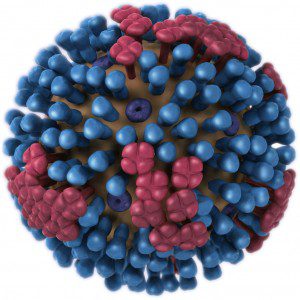

The mucus layer of the respiratory tract has a defensive role because it contains soluble glycoproteins that are rich in sialic acids, which are cell receptors for some viruses. When influenza virions enter the respiratory tract, they are thought to be trapped in mucus where they bind sialic acids, preventing infection of the underlying cells. The role of NA in penetration of the mucus layer was studied in frozen sections of human tracheal and bronchial tissues, in which the mucus layer is preserved. Influenza A virions bind to this mucus layer; the interaction is blocked when the tissues are first treated with a bacterial neuramindase, which removes sialic acids from glycoproteins. These observations indicate that the mucus layer of human airway epithelial cells contain sialic acid-containing decoys that bind influenza A viruses.
Human salivary mucins, which approximate the mucus of the human respiratory tract, can protect cultured cells from influenza virus infection. The protective effect can be achieved by simply adding the mucins to cells. The inhibitory effect is dependent on the sialic acid content of the mucins: fewer cells are infected when higher concentrations are used. In contrast, porcine salivary mucins do not substantially reduce influenza virus infection. The type of sialic acids and the virus strain also determine the extent of protection.
To determine the role of the viral NA in mucin-mediated inhibition, Tamiflu was mixed with virus before infection of mucus-coated cells. The presence of Tamiflu increased the inhibition of infection caused by mucins, indicating that the sialic acid-cleaving (sialidase) activity of NA is needed to overcome inhibition by human salivary mucins. When influenza virions are incubated with human salivary mucins linked to beads, sialic acids are cleaved from mucins, and this enzymatic activity is inhibited by Tamiflu. Human salivary mucins inhibit NA by binding to the active site of the enzyme.
These studies establish a clear role for the influenza viral NA in bypassing the defenses of the mucosal barrier. An important message is that not all strains of influenza virus are equally inhibited by mucus; presumably this property is one of many that determines viral virulence. The balance between how tightly the viral HA binds to sialic acids, and how well the NA cleaves them, is probably one predictor of how well we our protected by our mucus.

Pingback: Cutting through mucus with the influenza virus ...
now measure mucus thickness and Sia content
and what nutrition, medication,air quality, behaviour affects it !
> mucus layer (up to 50 μm thick)
That’s 500 virus-diameters to be traveled through (how ?)
before it’s cleared.
So when you think you might have caught flu, try to clear the mucus (how ?)